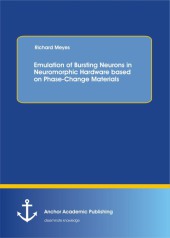 Neuerscheinungen 2015Stand: 2020-02-01 |
Schnellsuche
ISBN/Stichwort/Autor
|
Herderstraße 10
10625 Berlin
Tel.: 030 315 714 16
Fax 030 315 714 14
info@buchspektrum.de |

Richard Meyes
Emulation of Bursting Neurons in Neuromorphic Hardware based on Phase-Change Materials
Erstauflage. 2015. 124 S. 220 mm
Verlag/Jahr: ANCHOR ACADEMIC PUBLISHING 2015
ISBN: 3-9548934-4-4 (3954893444)
Neue ISBN: 978-3-9548934-4-7 (9783954893447)
Preis und Lieferzeit: Bitte klicken
Text Sample:
Chapter 2 A Biological Background:
The Human brain is vastly superior to the brain of other animals in its ability to exploit the physical environment in which the controlled organism has to operate. The remarkable complexity of the environment that humans created for themselves since the beginning of their existence depends on the connection of highly sophisticated arrays of sensory receptors to an extremely flexible neuralmachine - a brain - which provides the possibility to discriminate an enormous variety of events in the environment. The brain organizes the continuous stream of information from these receptors into perceptions which are partly stored inmemory for future references. These perceptions are then organized into appropriate behavioral responses. All of this is accomplished by the brain using nerve cells that are connected to each other via synapses. Even though the nervous system has two classes of cells, nerve cells (neurons) and glial cells (glia), which outnumber neurons by a factor of 10 - 50, within the framework of this thesis only structural and functional properties of neurons are dealt with because neurons are themain signaling units of the nervous system. [13]
2.1. The Neuron:
The Neuron is the basic processing unit of the brain. The human brain contains an extraordinary number of these morphologically simple units (of the order of 1011 neurons), each of which has about 103 connections to other units. Although classifiable into at least a thousand different types, all neurons share the same basic architecture. Different ways in which neurons with basically similar properties are connected to each other can, nevertheless, lead to quite different characteristics of the resulting entities. The basis for the complexity of human behaviour is formed by the fact that numerous neurons constitute precise anatomical and functional entities rather than by the specialization of individual neurons. In order to appreciate how information in the nervous system is processed it is necessary to begin with with the structural and functional properties of neurons and then to deal with the mechanisms that are responsible for the generation and processing of signals. [13]


